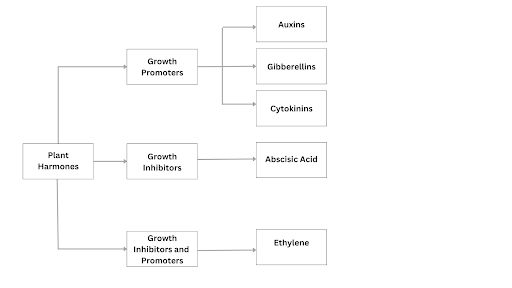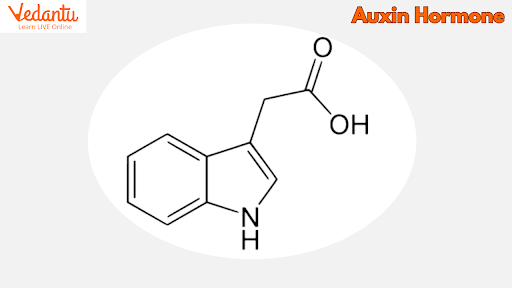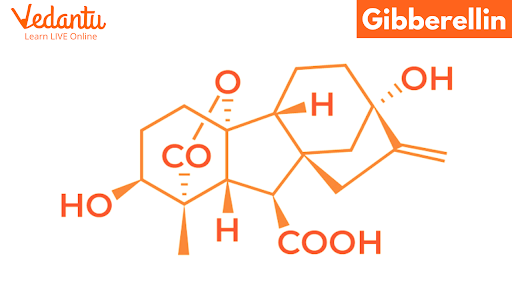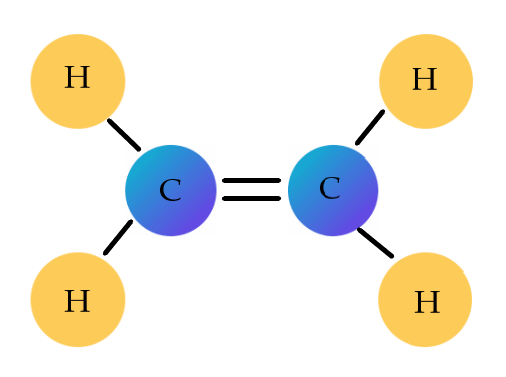




What are Plant Hormones and Their Functions
Plant hormones (also known as phytohormones) are signal molecules that exist at extremely low concentrations and are formed within plants. From embryogenesis, organ size regulation, pathogen protection, stress tolerance, and reproductive development, plant hormones regulate all aspects of plant growth and development. There are some intrinsic variables that control plant growth and development.
Some examples of plant hormones are Indole (auxins), terpenes (Gibberellins), adenine (Cytokinins), carotenoids (Abscisic acid), and gases (Ethylene).
In nearly all parts of the plant, these hormones are produced and are transferred to different parts of the plant.
Plant hormones may act individually or synergistically. It may be complementary or antagonistic to the functions of various hormones.
Hormones, along with extrinsic influences, play an important role in processes such as vernalization, seed germination, phototropism, dormancy, etc.
In regulated crop production, synthetic plant hormones are exogenously added.
Phototropism in the canary grass coleoptiles was first observed by Charles Darwin and auxin was first isolated from the coleoptiles of oat seedlings by F.W Went.
Note: 👉Explore Your Medical College Options with the NEET Rank and College Predictor 2025.
What are Plant Hormones?
For their survival and growth plants require a lot of natural aid like water, oxygen, sunlight and various minerals and nutrients. All these are external factors that help in the development of plants . In addition to these, there are some intrinsic factors that help in their growth. These intrinsic factors that we just talked about are called plant hormones or Phytohormones. Plant Hormones help in regulating the growth of plants.
Let us now understand what plant hormones are according to the NEET syllabus:
Plant hormones are chemical compounds found in a plant's body in a very low concentration. They mainly derive from indole (auxins), terpenes (Gibberellins), adenine (Cytokinins), carotenoids (Abscisic acid) and gases (Ethylene).
These are produced in every part of the plant and circulate throughout a plant’s body.
Each hormone has its own role in a plant’s body. Different hormones carry out different functions individually or in combination with other hormones.
Hormones play a very important role in a plant’s body and facilitate processes like vernalisation, phototropism, seed germination, dormancy etc. with the help of external factors like sunlight, water and oxygen.
Crop production is controlled by the application of synthetic hormones.
Main Functions of Plant Hormones
All the growth and development activities such as cell division, enlargement, flowering, seed formation, dormancy, and abscission are regulated by plant hormones and are the main functions of plant hormones.
Plant hormones are categorised into two groups based on their action:
Plant Growth Promoters.
Plant Growth Inhibitors.

Types of Plant Hormones and their Functions
1. Auxin
Auxin means "to be able to grow." In agricultural and horticultural practises, they are widely used. They are found in roots and stems in rising apices and then move to other parts of the plant.

Example of plant hormone Auxin:
Natural: Indole butyric acid (IBA), and Indole-3-acetic acid (IAA)
Synthetic: NAA (Naphthalene acetic acid) and 2,4-D (2,4-Dichlorophenoxyacetic acid)
Functions of Plant Hormone Auxin:
Elongation of cells of stems and roots.
IAA in apical buds suppresses the development of lateral buds with apical dominance.
Induces parthenocarpy, i.e. fruit growth without fertilisation, for example, in tomatoes.
Prevent leaves, flowers, and fruits from dropping prematurely.
Useful in stem cuts and grafting where rooting is initiated.
Promotes flowering in, for example, pineapple.
2,4-D is commonly used to destroy unwanted dicot weeds without harming monocot plants.
Contributes to cell division and xylem differentiation.
2. Gibberellin:
There exist more than a hundred (100) known Gibberellins (GA1, GA2, GA3..). In nature, they are found to be acidic. These kinds of hormones are majorly observed in higher plants and fungi.

Functions of Plant Hormone Gibberellin:
Promotes bolting, i.e. sudden internode elongation just before flowering, as seen in cabbage, beet, and others.
Brings delays in senescence.
Stimulates parthenocarpy.
Stem elongation and reversing dwarfism.
In plants such as cannabis, it induces maleness.
Promotes the synthesis of hydrolytic enzymes such as amylase, lipase, in the endosperm of germinating barley seeds and cereal grains.
3. Cytokinins:
Cytokinins play a major role in the mechanism of cytokinesis. rIn plants where rapid cell division occurs, cytokinins are naturally synthesised, such as root apices, shoot buds, young fruits, etc. Cytokinins show basipetal and polar movement.
(Image will be Uploaded soon)
Example of plant hormone Cytokinins:
Natural: isopentenyl adenine and Zeatin (corn kernels, coconut milk).
Synthetic: Benzyladenine, Kinetin, thidiazuron, and diphenylurea.
Functions of Plant Hormone Cytokinins:
This promotes lateral and adventitious shoot growth and is used in culture to initiate shoot production.
Assists in resolving auxin-induced apical dominance.
Stimulate the production of chloroplast in the leaves.
Promoting the mobilisation of nutrients and slowing leaf senescence.
4. Abscisic Acid:
It is a hormone that has a role in inhibiting the growth of plants. ABAs serve as an opponent to GAs. It prevents the metabolism of plants and controls abscission and dormancy. It is often referred to as a 'stress hormone' as it improves plant tolerance.
(Image will be Uploaded soon)
Functions of Plant Hormone Abscisic Acid:
Induces abscission of fruits and leaves.
Inhibits germination of seeds.
Induces leaf senescence.
Accelerates seed dormancy, which is useful for storage purposes.
Stimulates stomatal closure to stop transpiration under water stress.
5. Ethylene:
Ethylene acts as both inhibitor as well as a growth promoter. It Occurs in gaseous form. The synthesis of ethylene occurs in the maturing fruit and tissues which are undergoing senescence. Many physiological procedures are regulated by this hormone and are one of the most commonly used hormones in agriculture.

Functions of Plant Hormone Ethylene:
It speeds up the fruit ripening.
Controls leaf epinastine.
Breaks the bud and seed dormancy.
Facilitates rapid elongation of internodes and petioles.
Senescence and abscission of leaves and flowers are encouraged.
This raises the absorption surface by inducing root growth and root hair formation.
Stimulates femininity in plants that are single.
Formation of the apical hook in dicot seedlings.
Application of Plant Hormones:
Tissue Culture.
Somatic Cell Hybridization.
Introduction of recombinant DNA into protoplasts.
Conclusion
Plant hormones are chemical messengers produced by plants to regulate growth, development, and response to environmental stimuli. Plant harmones and their functions include auxins, cytokinins, gibberellins, abscisic acid, and ethylene. Auxins control cell elongation and apical dominance, cytokinins promote cell division and delay aging, gibberellins stimulate stem elongation and seed germination, abscisic acid regulates dormancy and stress responses, while ethylene influences fruit ripening and senescence. Understanding what are plant hormones and their roles in plant physiology is vital for agriculture, enabling manipulation of growth patterns, crop yield, and stress tolerance. Emphasizing their interplay and application in agricultural practices can enhance sustainable crop production and environmental resilience.
FAQs on Plant Hormones
1. Which of the hormones are present in the form of gases?
Ethylene is the hormone that is present in the form of gases. Ethylene is known to be a multifunctional phytohormone that controls both development and senescence. Depending on its concentration, the timing of application, and the plant species, it promotes or inhibits growth and senescence processes.
2. Name the most important plant hormone?
Abscisic acid (also called ABA) is the most crucial plant growth regulator. Abscisic acid (ABA) is a significant phytohormone that controls the development, growth, and stress responses of plants. It plays a vital role in various plant physiological processes, including stomatal closure, accumulation of cuticular wax, leaf senescence, dormancy of buds, germination of seeds, osmotic control, and inhibition of growth, among many others. Abscisic acid regulates downstream responses by both transcriptional and posttranscriptional mechanisms to abiotic and biotic environmental changes.
3. What are plant hormones?
Plant hormones, also called phytohormones, are chemical messengers produced in tiny amounts throughout a plant. They play a crucial role in regulating all aspects of plant growth and development, from seed germination to flowering and fruit ripening. Unlike animals, which have specific organs for hormone production, plant cells can all produce hormones.
4. Mention the types of plant hormone?
The major types of plant hormones are:
Auxins
Gibberellins
Cytokinins
Abscisic Acid (ABA)
Ethylene
These hormones often work together in complex ways to regulate plant growth and development. For instance, auxin and cytokinin can work together to stimulate cell division and bud growth. Conversely, ABA can counteract the effects of gibberellins and cytokinins.
5. Does plant hormones help plants grow?
Yes, absolutely! Plant hormones, also called phytohormones, are crucial for all aspects of plant growth and development. They act like chemical messengers, produced in tiny amounts throughout the plant and influencing everything from seed germination to stem growth, flowering, and fruit production.
6. How do plant hormones produce their effects?
Plant hormones are like tiny control switches. They travel to different parts of the plant and interact with plant cells at very specific locations. This interaction triggers various responses within the cells, influencing growth, development, or other physiological processes.
7. Name a few phytohormones
Plants have these special chemicals called phytohormones that help control their growth and development. Some important ones include auxins, gibberellins, cytokinins, ethylene, and abscisic acid. There are also others like brassinosteroids, salicylates, jasmonates, and strigolactones that play a role in how plants function.
8. How can plant hormones be used?
Understanding plant hormones has led to many agricultural applications. Herbicides can target specific hormone pathways to control weeds. Synthetic hormones can be used to promote desired effects, such as fruit set or delaying flower drop.
9. What factors affect plant hormones?
Light, temperature, and stress can all influence plant hormone production. For instance, lower light levels can stimulate stem elongation due to changes in auxin production.
10. Can plant hormones affect humans?
Some plant hormones can have effects on humans, although not in the same way they regulate plants. For example, some fruits contain auxin-like compounds that can influence human cell division. However, this is generally not a cause for concern in normal dietary intake.
11. Why do plants need hormones?
Since plants can't move around, hormones provide a way for them to coordinate different parts and respond to their environment. They allow the plant to optimize its growth, reproduction, and defense mechanisms.
12. Can hormones be found in plants?
Yes! Unlike animals where hormones are produced in specific glands, plant cells throughout the plant can synthesize hormones. This allows for a more distributed and flexible hormonal control system.























